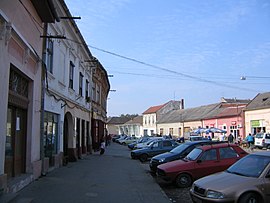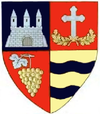Lipova, Arad
Lipova | |
|---|---|
 | |
 Coat of arms | |
 Location in Arad County | |
 Lipova Location in Romania | |
| Coordinates: 46°5′30″N 21°41′30″E / 46.09167°N 21.69167°ECoordinates: 46°5′30″N 21°41′30″E / 46.09167°N 21.69167°E | |
| Country | Romania |
| County | Arad |
| Government | |
| • Mayor (2020–2024) | Florin-Fabius Pera[1] (PSD) |
| Population (2011)[2] | 10,313 |
| Time zone | EET/EEST (UTC+2/+3) |
| Vehicle reg. | AR |
| Website | www |
Lipova (Romanian pronunciation: [ˈlipova]; German and Hungarian: Lippa; Serbian: Липова, Lipova; Turkish: Lipva) is a town in Romania, Arad County, located in the Banat region of western Transylvania. It is situated at a distance of 34 km from Arad, the county capital, at the contact zone of the river Mureș with the , Western Plateau and Lipova Hills. It administers two villages, Radna (Máriaradna) and Șoimoș (Solymosvár), and its total surface is 134.6 square km.
The first written record of the town dates back to 1315 under the name Lipwa. In 1324 the settlement was mentioned as castellanus de Lypua, a place-name that reflects its reinforced character of that time.
Population[]
| Year | Pop. | ±% |
|---|---|---|
| 1930 | 6,000 | — |
| 1948 | 6,556 | +9.3% |
| 1956 | 10,064 | +53.5% |
| 1966 | 11,705 | +16.3% |
| 1977 | 11,863 | +1.3% |
| 1992 | 12,059 | +1.7% |
| 2002 | 11,491 | −4.7% |
| 2011 | 9,648 | −16.0% |
| Source: Census data | ||
According to the census of 2011 the population of the town was 9648 inhabitants. The ethnic groups were: 94% Romanians, 2.89% Hungarians, 1.47% Roma, 1.27% Germans, 0.07% Slovaks, 0.18% Ukrainians and 0.1% of other or undeclared nationalities.
Etymology[]
Its name is derived from the Slavic word lipa, linden tree with suffix.[3]
History[]

Situated at the crossing of the roads leading to Transylvania, Banat and Wallachia, Lipova had a history full of vicissitudes. It was situated strategically at the Mureș's exit from the defile, and consequently it was an extremely enviable centre. After the Tartar invasion in 1241 the fortresses were rebuilt, and the lines of the future urban settlement started to get contoured around the castle. Several names of famous historical personalities are related to this castle, such as John Hunyadi, Matthias Corvinus, György Dózsa, John Zápolya etc. Due to the continuous disputes, the town has become four times under Turk administration (between 1552 and 1595, between 1613 and 1686, between 1690-1691 and between 1695 and 1716), and starting with 1716 it became under Habsburg domination. In the 18th-19th centuries Lipova was a well-developed economic centre with famous craftsmen working here. In the period of the revolution in 1848-49 and in the beginning of the 20th century Lipova became an important centre of political and national emancipation, due to the activity of remarkable personalities, such as Nicolae Bălcescu, Vasile Goldiș, and .
Șoimoș castle has also taken part from the successive vicissitudinary periods related to the historical events of Lipova and to the defensive role of the main entrance gate from Transylvania.
Tourist attractions[]
The car industry, light industry, services and tourism are the most representative economic sectors. The tourist sites of the town include both natural and anthropic elements. Due to the abundance of tourist attractions, Lipova is an important tourism centre. The natural reservation "Balta Șoimoș", the Șoimoș castle, the monastery called "Saint Mary" in Radna, the church called "Buna Vestire" in Șoimoș, the church named "Adormirea Maicii Domnului", the town museum, the "Sub dughene" bazaar (Turkish bazaar), the environs of the town-hall (Nicolae Bălcescu Street) and the thermal bath where springs with curative mineral water flow.
Natives[]
- Carmen-Francesca Banciu, novelist
- Ion Vincze, communist activist
- Jovan Nenad, self-declared Emperor of Serbia
- Tinu Veresezan, singer
References[]
- ^ "Results of the 2020 local elections". Central Electoral Bureau. Retrieved 8 June 2021.
- ^ "Populaţia stabilă pe judeţe, municipii, oraşe şi localităti componenete la RPL_2011" (in Romanian). National Institute of Statistics. Retrieved 4 February 2014.
- ^ Iordan, Iorgu (1963). Toponimia romînească. Bucharest: Editura Academiei Republicii Populare Romîne. p. 99. OCLC 460710897.
External links[]
| Wikimedia Commons has media related to Lipova. |
- Populated places in Arad County
- Towns in Romania
- Localities in Romanian Banat
- Spa towns in Romania
- Place names of Slavic origin in Romania
- Former capitals of Hungary

